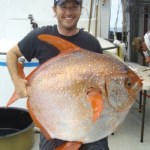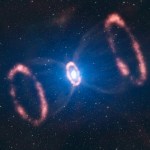discovery
By now you have probably seen the video showing the discovery of a strange purple blob during an exploration off the coast of California. As a scientist what do you do when you find something new? You bring it back to the lab of course. Although it may take years to identify what it is, the researchers have speculated it might be some new species of soft-bodied mollusk. Check out the newly uploaded YouTube video:
NOAA image of a possible new species of octopus discovered near Hawaii. Photo credit: AP, NOAA
Scientists from the National Oceanic and Atmospheric Administration (NOAA) think they have discovered a new species of octopus while exploring the ocean floor around Necker Island (near Hawaii). The octopus was found 4,290 meters deep. Interestingly, fins were absent from the pale octopus, which NOAA scientist Michael Vecchione noted was unusual for an octopus living at that depth. Moreover, its suckers were found to be in a single row on each of its arms, as opposed to two rows.…
Nick Wegner (Southwest Fisheries Science Center) is pictured here holding an opah. Image Credit: NOAA Fisheries, Southwest Fisheries Science Center
The opah (Lampris guttatus), otherwise known as a moonfish, lives in the deep sea where warm blood can be advantageous. According to a quote from Nicholas Wegner (NOAA) posted in Live Science, "Increased temperature speeds up physiological processes within the bod. As a result, the muscles can contract faster, the temporal resolution of the eye is increased, and neurological transmissions are sped up. This results in faster swimming speeds…
Greg Laden reports on a hominid fossil "recovered from the seabed near Taiwan" which reveals new levels of dental diversity among proto-humans and may qualify as a new species. Greg says the specimen known as Penghu "is yet another indicator that multiple different hominids lived on the Earth at the same time after the rise of Homo erectus." But why was it located underwater? In another example of what lies beneath, Dr. Dolittle marvels at "an unexpected find and very exciting moment for researchers;" the discovery of small fish and invertebrates thriving below 740 meters of ice near the…
"The results of my observation are best explained by the assumption that a radiation of very great penetrating power enters our atmosphere from above." -Victor Hess
You might think of the largest and most powerful particle accelerators in the world -- places like SLAC, Fermilab and the Large Hadron Collider -- as the source of the highest energies we'll ever see. But everything we've ever done hear on Earth has absolutely nothing on the natural Universe itself! For this week's Ask Ethan, let's take a look at the simple question of our reader David Hurn, who asks:
Ever since I was a young…
"Do you see the absurdity of what I am? I can't even express these things properly because I have to - I have to conceptualize complex ideas in this stupid limiting spoken language! But I know I want to reach out with something other than these prehensile paws! And feel the wind of a supernova flowing over me!" -Ronald Moore
Well, you probably don't actually want to feel the wind of a supernova flowing over you; trust me on this.
Image credit: ESO / L. Calçada, of the remnant of SN 1987a.
But to find one for yourself, that's definitely within your reach, if you know where to look.…
"Give me a coin. <Takes Coin.> All right. Uh... heads, I win, tails, you lose. Right? <Flips coin.> Tails, you lose." -Ralph Kramden
All things being equal, you're well aware that if you flipped a completely fair coin, you'd have a 50% chance of it landing on heads, and a 50% chance of landing on tails (ignoring the side, of course).
Image credit: C. Nolan, A. Eckhart and Warner Bros. Pictures, retrieved from http://explow.com/Two-Face.
So let's imagine that you flip the coin ten times, and you get seven heads and three tails. Are you worried? You shouldn't be; in…
“If you end up with a boring miserable life because you listened to your mom, your dad, your teacher, your priest, or some guy on television telling you how to do your shit, then you deserve it.” -Frank Zappa
Inside of every student I've ever taught lives a passionate, curious mind that can either flourish or stagnate, both inside and outside the classroom. The teachers that get it -- that get you -- are the ones that help bring you there, but that is not all teachers, not by any means. I think everyone, by this point in their life, has had experience with at least one teacher that…
By Dr. Gerry Harp, Senior Astrophysicist, Center for SETI Research, SETI Institute, and Gail Jacobs
Trained as a quantum mechanic, Dr. Gerry Harp was deeply interested in possibilities for using the multiple telescopes of the Allen Telescope Array to generate steerable "beams" on the sky -- beams that could be far smaller than any single antenna could produce. Such beams don't emit anything, but work in reverse by capturing only energy that comes from the sky in a certain direction. Gerry joined the SETI Institute in 2000, practically at the telescope's inception and uses the telescope for…
On Universe, Claire L. Evans looks back on the starry-eyed futurism of the 1970's, when Gerard O'Neill envisioned "massive colonies of human habitation in space—self-sustaining environments capable of hosting hundreds of thousands of people." These colonies, housed in spinning cylinders, "would float in space at Lagrangian points, points of stable gravitational equilibrium located along the path of the moon's orbit." Today our ambitions are a bit less grand—and perhaps we should focus on taking care of the perennial spaceship Earth. But with unlimited room to grow and plenty of solar…
The Universe is a little less than 14 billion years old. Humanity, maybe 200,000. We have reached for knowledge at every step, and recorded what we could. The pace of our knowledge seems to accelerate; the 20th century tranformed our understanding of reality, as had the previous millenium. In 2011, we gather more information than ever before, and our knowledge seems almost complete. But it's funny how things change. On Built on Facts, Matt Springer says James Clerk Maxwell's electromagnetic equations are as good today as they were in the 1860's, despite a little thing called relativity. Matt…
Many years ago, as I was writing up my thesis, my advisor burst into my office with the hot news.
Someone had announced a possible discovery of an extrasolar planet!
It seems strange now, but back then we really did not know if there were any other planets around other stars.
A lot of astronomers thought that it was quite likely that there were planets around other stars, maybe even most stars, but we had no data.
We were getting there, there were astrometric and radial velocity searches underway, with people like Walker, Griffin and Latham developing techniques which would clearly,…
It's time for round two!
Tell us: If you could make one new scientific discovery or invention, what would it be?
We will turn your answers into a beautiful Word Cloud! Submit your answers and see the results in the next newsletter!
An image of our first Wordle which asked: Who is your favorite scientist of all time?
Help us spread the word:
Forward this question and link to your friends or post it on Facebook.
Collect your students' answers and enter them into the form.
Have ideas for questions we should ask the nation? Submit them here.
To find out more about Wordles and to create…
NPR reports on the discovery of a bee that builds tiny, multi-coloured nests out of flower petals. The rare solitary bee Osmia avoseta creates the cocoons out of a mixture of mud, flower petals and nectar. Each case holds a single egg.
The discovery by a group of scientists in Turkey co-incided with that of another team in Iran; the two groups published their findings together in the American Museum Novitae. More pictures and info on NPR.org.
Using the Hubble Telescope, scientists have successfully viewed a planet revolving around a different star than our beloved Sun for the first time. The planet has been dubbed Fomalhaut b and revolves around the star Fomalhaut, the brightest star in the constellation Piscis calculated to reside about 25 light years away. ScienceBlogger Steinn Sigurðsson broke the news on Dynamics of Cats, and has posted multiple images of the planet.
Martialis heureka Rabeling & Verhaagh 2008
drawing by the inimitable Barrett Klein for PNAS
Most scientific discoveries these days emerge through carefully planned and controlled research programs. Every now and again, though, something unexpected just pops up in a distant tropical jungle. Martialis heureka is a fantastic discovery of that old-fashioned kind. This little ant simply walked up to myrmecologist Christian Rabeling in the Brazilian Amazon. It is not only a new species, but an entirely different sort of ant than anything known before.
The…
Remember how I told you earlier this week that DAMA was going to announce that they found dark matter, even though the signal that they found is not consistent with other experiments?
Looks like my powers of predicting the future are pretty damned good. They have a new plot with more data showing the continued modulation at a certain energy range:
and also one showing the fact that they see a bunch of extra events happening in that energy range:
So here's the stuff that DAMA has seen: a nuclear recoil that has many events in a certain energy range, and has a 2% annual modulation in that…
The DAMA collaboration, an experimental team searching for dark matter via direct detection, is poised to report this week that they have discovered Dark Matter. And I'm here to pre-empt that by bringing you the truth: no, they haven't.
They take some very cold (cryogenic) atoms,
look for nuclear recoils resulting from dark matter collisions, subtract the background, and draw conclusions based on whatever's left over. Their expectations are based on the following:
Neutrons, neutrinos, and other standard model particles from the Earth, the Sun, and the Milky Way galaxy will collide with the…









